Saturday, August 27, 2005
08/03/08 Wednesday through 08/08/05 Monday - Tok to Fairbanks
08/03/05 Wednesday through 08/08/05 Monday
Today we went from Tok to Fairbanks. The trip was a very uneventful 199 miles. Our travel buddies were Bob and Marylou St. Germaine from Averill Park, NY. Bob is a retired metal worker. Be designed and built molds for sheet metal projects. He was telling Mary about some project he did for the first president Bush. I don’t remember just what it was, but Bob was real proud of it. It was something personal, maybe pertaining to a horse.
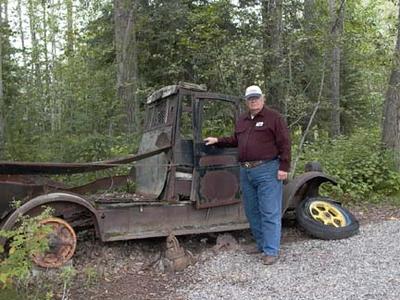
From Tok to Delta Junction we ran the last 105 miles of the Alaska Highway. We ran along the Eastern edge of the Alaska Mountain Range. There were some nice views there of some high peaks with a lot of snow on them.
We passed throu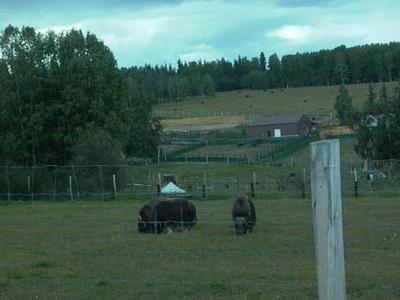 gh Dot Lake Village that is the Tanana Valley traditional Athabascan village. It was not a tourist site, but the homes of the local Indians. It would have been interesting to have stopped and visited with them, but there was no sign that the public was welcome to come in.
gh Dot Lake Village that is the Tanana Valley traditional Athabascan village. It was not a tourist site, but the homes of the local Indians. It would have been interesting to have stopped and visited with them, but there was no sign that the public was welcome to come in.
When we got to Delta Junction we stopped at the Visitors center. Delta Junction is a pretty good-sized town with a population of about 3500 people. It marks the end of the Alaska Highway. The historic 1422 mile pole is located in the visitor’s center. There is also some history of the Alaska Pipeline in the center. We visited there for a while then we went on to a place called Rika’s Roadhouse for lunch. This is the neatest place we have had for lunch since we have been traveling. It is the location of an old homestead. The house and all the outbuildings are all still there. Some had had some restoration, but they appear in their original condition, even the springhouse and the blacksmith shop. The gift shop was in the old house and some of the rooms still were furnished with the inventory sitting around on shelves and tables. The obvious addition was the restaurant. It also had a gift shop. Mary tried on a fur jacket of some kind. It looked real nice on her but I just took a picture and she hung it back up because it cost $3500.

The Tanana River is the major waterway in this area and it led us to Fairbanks. The Tanana River Bridge and Pipeline crossing is our first actual sighting of the Pipeline. This is on the Richardson Highway north of Delta Junction. We also crossed the Grestle River on the Black Veterans Memorial Bridge. This bridge was built in 1944 and was so named to commemorate the 3695 Black soldiers who worked on the Alaska Highway.
About twenty miles before we got to Fairbanks we passed Eielson Air force Base. A formation of planes, I think they were probably fighter planes of some sort, flew past us.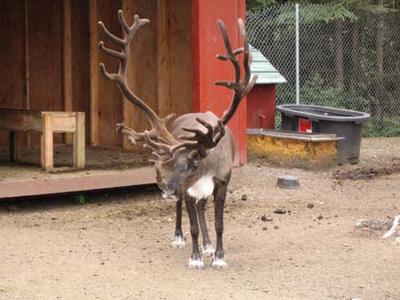 Up ahead the first one on the left banked to his left, circled and flew back toward us. In about eight to ten second intervals the other three all banked and followed. Just after the last on passed us coming back toward us, the first one landed on a runway right along side of the highway. Mary got pictures of the other three as they the landed beside us. Later she was telling someone in our group about it and she was told that she was not supposed to be taking pictures. Of course, she had no idea that she should not take pictures. Later when we looked at the pictures from the day, she saw a sign in the first picture she took of the planes. It read in big letters NO STOPPING AND DO NOT TAKE PICTURES.
Up ahead the first one on the left banked to his left, circled and flew back toward us. In about eight to ten second intervals the other three all banked and followed. Just after the last on passed us coming back toward us, the first one landed on a runway right along side of the highway. Mary got pictures of the other three as they the landed beside us. Later she was telling someone in our group about it and she was told that she was not supposed to be taking pictures. Of course, she had no idea that she should not take pictures. Later when we looked at the pictures from the day, she saw a sign in the first picture she took of the planes. It read in big letters NO STOPPING AND DO NOT TAKE PICTURES.
Just before we got to Fairbanks we passed through a little town named North Pole. Of course, there was a lot of Christmas and Santa Claus stuff there. We did not stop, but we will go b back out there. We are going to be in Fairbanks until next Tuesday. There is a lot of history to see here. Fairbanks started out as a trading post founded by ET Barnette on the banks of the Tanana River It was a struggle for a while and then an Italian immigrant named Fleix Pedro struck gold. With Barnette promoting the strike, they started a stampede of prospectors from the gold camps in the Klondike looking for better fortune. Fairbanks quickly grew into the largest city in Alaska and it still is.
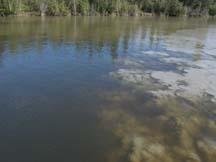 We checked in at Riverside RV Park just outside of town, after we were settled we got on a bus and went down to a place named Pioneer Park for a Salmon Bake. We had Salmon, fried Halibut and Cod, Prime Rib and all the trimmings. Later we went to a really fun and educational stage show about the founding and early days of Fairbanks.
We checked in at Riverside RV Park just outside of town, after we were settled we got on a bus and went down to a place named Pioneer Park for a Salmon Bake. We had Salmon, fried Halibut and Cod, Prime Rib and all the trimmings. Later we went to a really fun and educational stage show about the founding and early days of Fairbanks.
We have a lot of interesting things to do here during the next four days. I just hope the weather cooperates. We have good phone service and we have Y_FI so we can get on the Internet when we need to. We are going to try to get our blog working.
On Thursday, 08/04/05, we had a full day of touring. We started off with a city tour. It was a waste because we had a driver who was on his first trip. He didn’t know what to tell us about what we were seeing. If our wagon master hadn’t been on this caravan about seven times we would have gotten no information about the city. He just took over the tour and let the other guy drive. He did know how to get us to where we were going.
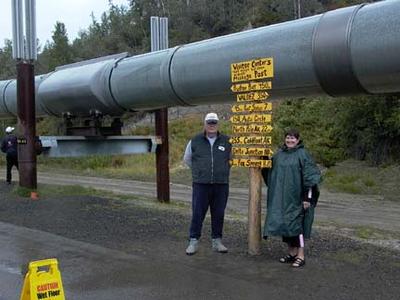 Our first stop was at the visitor’s center for the Alyeska Pipeline. That is the spelling that was on the sign. We learned a lot about the line and it’s construction. It is a bigger pipe than I visualized and it runs a lot of miles. When you consider the climate, especially temperature, it is amazing that they have been able to keep it flowing. They built it with expansion and constriction ability by putting slight S shaped curves in it to allow it to stretch and shrink. We also saw something which they call “PIGS”. The things run through the pipe, propelled by the flow of the oil. There are smart pigs and dumb pigs. The dumb pig just keeps the walls of the pipe cleared of paraffin that forms from the oil flow. The smart pig inspects the pipe as well as cleaning it. It records data about the condition of the oil flow and identifies areas where potential problems exist from corrosion and weakness in the material from which the pipe is made.
Our first stop was at the visitor’s center for the Alyeska Pipeline. That is the spelling that was on the sign. We learned a lot about the line and it’s construction. It is a bigger pipe than I visualized and it runs a lot of miles. When you consider the climate, especially temperature, it is amazing that they have been able to keep it flowing. They built it with expansion and constriction ability by putting slight S shaped curves in it to allow it to stretch and shrink. We also saw something which they call “PIGS”. The things run through the pipe, propelled by the flow of the oil. There are smart pigs and dumb pigs. The dumb pig just keeps the walls of the pipe cleared of paraffin that forms from the oil flow. The smart pig inspects the pipe as well as cleaning it. It records data about the condition of the oil flow and identifies areas where potential problems exist from corrosion and weakness in the material from which the pipe is made.
We went next to the Eldorado Gold Mine. Our tour here was probably as good as any I have ever been on. We got on a train as soon as we got there. We had a host who told us stories and played the fiddle. His granddaddy had been a fiddle player for some country music folks and had been on the Grand Ole Opry.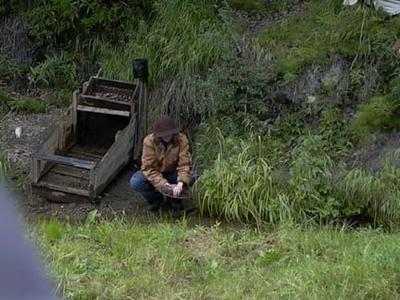 He told us the history of the mine when we started up to the mine. They presented the history on sites along the track so we just stopped the little train and could look out, hear and even get pretty good pictures. We saw a sourdough camp, a tent where miners lived. Then we saw a miners cabin like they built after they had a claim and were working in one site. The person who was the miner even was working a cradle sluice and panning the creek. The next thing we saw was a donkey engine digging with an ore bucket and piling the dirt up go be washed in the spring when it thawed. They had a rule, dig in the winter and wash in the summer. When we got up to the location of the mine we were met by a couple that were actually still working a claim nearby. They worked for the company giving the tours as well. We saw how sluice boxes worked. The dumped a backhoe bucket of dirt into the sluice box and worked it down. They filled bags from what was left in the sluice box and gave each of us a bag and a pan.
He told us the history of the mine when we started up to the mine. They presented the history on sites along the track so we just stopped the little train and could look out, hear and even get pretty good pictures. We saw a sourdough camp, a tent where miners lived. Then we saw a miners cabin like they built after they had a claim and were working in one site. The person who was the miner even was working a cradle sluice and panning the creek. The next thing we saw was a donkey engine digging with an ore bucket and piling the dirt up go be washed in the spring when it thawed. They had a rule, dig in the winter and wash in the summer. When we got up to the location of the mine we were met by a couple that were actually still working a claim nearby. They worked for the company giving the tours as well. We saw how sluice boxes worked. The dumped a backhoe bucket of dirt into the sluice box and worked it down. They filled bags from what was left in the sluice box and gave each of us a bag and a pan. 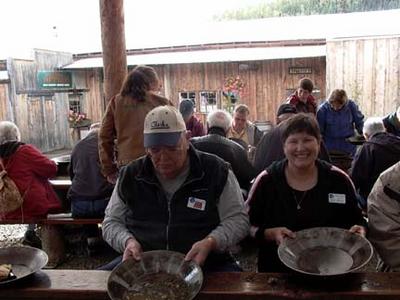 Mary and I worked the two bags of dirt that we got and we found 9.5 grains of gold, whatever that means. They told us at today’s market price it was worth $19.00. We bought Mary a locket with glass sides and put our gold in it, so she is carrying our entire gold mining fortune around her neck for the world to see.
Mary and I worked the two bags of dirt that we got and we found 9.5 grains of gold, whatever that means. They told us at today’s market price it was worth $19.00. We bought Mary a locket with glass sides and put our gold in it, so she is carrying our entire gold mining fortune around her neck for the world to see.
We finished up by shopping in their gift shops. I think that they mine more gold from tourists than they ever did when the mine was operating. We went to lunch at a great place called the Pump House. It actually was a pumphouse during the mining days. The building housed 10 pumps that pumped water over the mountains to the mines in Crippled Creek Valley. The strike there produced more gold per mile of creek than any other in Alaska. The restaurant served good food and moved our large group through in good time.
We went to the University of Alaska Fairbanks and went to their Museum of Natural History. They had very interesting exhibits of the wildlife of the region as well as the local Indian and Eskimo culture. We spent a couple of hours there and then we went to the Georgeson Botanical Gardens.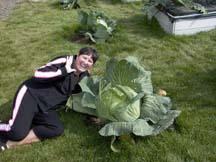 It was an experimental garden run by students at the university. They had the most beautiful flowers and some really nice vegetables. We saw a cabbage that was bigger than Mary’s head. We know because she lay on the ground and put here head beside it for a picture. They also had a farm where they raised Musk ox. We visited there and looked over the fence. Ugly animals.
It was an experimental garden run by students at the university. They had the most beautiful flowers and some really nice vegetables. We saw a cabbage that was bigger than Mary’s head. We know because she lay on the ground and put here head beside it for a picture. They also had a farm where they raised Musk ox. We visited there and looked over the fence. Ugly animals.
In the evening we had a meeting with the travel agent who was setting up the optional tours. We did not get our first c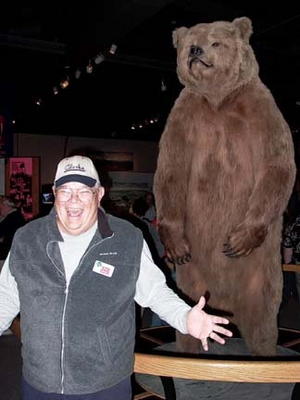 hoice, which was to fly to Point Barrow. It was filled up and we only got to go to Nome. We are scheduled to do that next Saturday, the 13th. Several people are going up there, but only one other couple is spending the night.
hoice, which was to fly to Point Barrow. It was filled up and we only got to go to Nome. We are scheduled to do that next Saturday, the 13th. Several people are going up there, but only one other couple is spending the night.
On Friday and Saturday we spent our time cleaning the house inside and out and doing some need shopping. Mary found her a small digital camera that she has been looking for and she has spent a lot of time learning how to use it. It is really a nice camera. We found the store by talking to some young folks who are stationed here in the Army. They are not looking forward to winter because they are from Miami. We met them while we were eating breakfast at a Denny’s which advertised itself as the northern most Denny’s in the world.
On Sunday 08/07/05 we went to North Pole, AK. We had dinner at a restaurant named the Elf’s Den it was all decorated for Christmas, which was kind of weird for August, but the food was good. After dinner we went to a small community that was named Esther Gold Camp. We saw a show at the Crown of Light Theater. It was called a Northern Lights Photosymphony. All slides and music, it was a good show. Then we went to a stage show at the “World Famous Malemute Saloon”. It was funny and entertaining. These kinds of shows are popular in the tourist traps. I think this our third one.
On Monday, 08/08/05 we went for a tour of a couple of the rivers on the Riverboat Discovery. I enjoyed this a lot and learned a good deal about the area from the guy who did the commentary for the trip as well as some folks who talked to us along the way. We boarded the boat on the Chena River and traveled down stream to the Tanana River, which is the bigger stream that empties into the Yukon. The Chena is a clear water stream and the Tanana is glacier melt and is a very gray, almost white, color. The contrast where they merged is remarkable. Besides the information that we got over the speakers, the most notable things were a visit to a sled dog training camp and an Indian village.
The first stop that we made was at a sled dog training camp that was owned and operated by Susan Butcher, who won the Iditarod Race about four or five times in the 1990’s. She was not there, but a young lady named Jessie Royer works for her and owns some dogs of her own. Evidently Jessie is a protégé of Susan’s and has performed well in the Iditarod in the last couple of years. I think her best finish was 8th. She talked to us about the dogs training schedule and diet as they prepared for the race. “Mushing” is a big competitive sport as well as a recreational sport up here.
She was not there, but a young lady named Jessie Royer works for her and owns some dogs of her own. Evidently Jessie is a protégé of Susan’s and has performed well in the Iditarod in the last couple of years. I think her best finish was 8th. She talked to us about the dogs training schedule and diet as they prepared for the race. “Mushing” is a big competitive sport as well as a recreational sport up here.
We also stopped at a mock up of an Athabascan Indian village and got of the boat for a tour. We had guides who took us through and talked to us about the society, culture, religion and day-to-day survival of a typical tribe. One of the most interesting things we saw was a fish wheel. It was turned b y the current of the river and scooped up salmon as they swam upstream to spawn. We also met an Athabascan lady named Dixie Alexander who did some of the most beautiful beadwork on leather that I have ever seen. There is a ceremonial dress which she made on display in the Museum of Natural History at the Smithsonian in Washington DC.
We had guides who took us through and talked to us about the society, culture, religion and day-to-day survival of a typical tribe. One of the most interesting things we saw was a fish wheel. It was turned b y the current of the river and scooped up salmon as they swam upstream to spawn. We also met an Athabascan lady named Dixie Alexander who did some of the most beautiful beadwork on leather that I have ever seen. There is a ceremonial dress which she made on display in the Museum of Natural History at the Smithsonian in Washington DC.
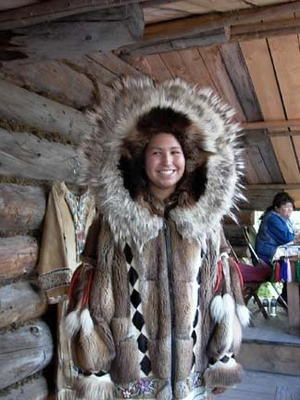
Small airplanes are a main mode of transportation up here. A large percentage of the fulltime residents are licensed pilots. As we traveled down the river most of the houses had a boat dock and along side it was a dock for an airplane with pontoons instead of wheels. We had a planned demonstration of taking off and landing on the river along side the boat.
Tonight we have our departure meeting for my favorite part of the trip.
Today we went from Tok to Fairbanks. The trip was a very uneventful 199 miles. Our travel buddies were Bob and Marylou St. Germaine from Averill Park, NY. Bob is a retired metal worker. Be designed and built molds for sheet metal projects. He was telling Mary about some project he did for the first president Bush. I don’t remember just what it was, but Bob was real proud of it. It was something personal, maybe pertaining to a horse.

From Tok to Delta Junction we ran the last 105 miles of the Alaska Highway. We ran along the Eastern edge of the Alaska Mountain Range. There were some nice views there of some high peaks with a lot of snow on them.
We passed throu
 gh Dot Lake Village that is the Tanana Valley traditional Athabascan village. It was not a tourist site, but the homes of the local Indians. It would have been interesting to have stopped and visited with them, but there was no sign that the public was welcome to come in.
gh Dot Lake Village that is the Tanana Valley traditional Athabascan village. It was not a tourist site, but the homes of the local Indians. It would have been interesting to have stopped and visited with them, but there was no sign that the public was welcome to come in.When we got to Delta Junction we stopped at the Visitors center. Delta Junction is a pretty good-sized town with a population of about 3500 people. It marks the end of the Alaska Highway. The historic 1422 mile pole is located in the visitor’s center. There is also some history of the Alaska Pipeline in the center. We visited there for a while then we went on to a place called Rika’s Roadhouse for lunch. This is the neatest place we have had for lunch since we have been traveling. It is the location of an old homestead. The house and all the outbuildings are all still there. Some had had some restoration, but they appear in their original condition, even the springhouse and the blacksmith shop. The gift shop was in the old house and some of the rooms still were furnished with the inventory sitting around on shelves and tables. The obvious addition was the restaurant. It also had a gift shop. Mary tried on a fur jacket of some kind. It looked real nice on her but I just took a picture and she hung it back up because it cost $3500.

The Tanana River is the major waterway in this area and it led us to Fairbanks. The Tanana River Bridge and Pipeline crossing is our first actual sighting of the Pipeline. This is on the Richardson Highway north of Delta Junction. We also crossed the Grestle River on the Black Veterans Memorial Bridge. This bridge was built in 1944 and was so named to commemorate the 3695 Black soldiers who worked on the Alaska Highway.
About twenty miles before we got to Fairbanks we passed Eielson Air force Base. A formation of planes, I think they were probably fighter planes of some sort, flew past us.
 Up ahead the first one on the left banked to his left, circled and flew back toward us. In about eight to ten second intervals the other three all banked and followed. Just after the last on passed us coming back toward us, the first one landed on a runway right along side of the highway. Mary got pictures of the other three as they the landed beside us. Later she was telling someone in our group about it and she was told that she was not supposed to be taking pictures. Of course, she had no idea that she should not take pictures. Later when we looked at the pictures from the day, she saw a sign in the first picture she took of the planes. It read in big letters NO STOPPING AND DO NOT TAKE PICTURES.
Up ahead the first one on the left banked to his left, circled and flew back toward us. In about eight to ten second intervals the other three all banked and followed. Just after the last on passed us coming back toward us, the first one landed on a runway right along side of the highway. Mary got pictures of the other three as they the landed beside us. Later she was telling someone in our group about it and she was told that she was not supposed to be taking pictures. Of course, she had no idea that she should not take pictures. Later when we looked at the pictures from the day, she saw a sign in the first picture she took of the planes. It read in big letters NO STOPPING AND DO NOT TAKE PICTURES.Just before we got to Fairbanks we passed through a little town named North Pole. Of course, there was a lot of Christmas and Santa Claus stuff there. We did not stop, but we will go b back out there. We are going to be in Fairbanks until next Tuesday. There is a lot of history to see here. Fairbanks started out as a trading post founded by ET Barnette on the banks of the Tanana River It was a struggle for a while and then an Italian immigrant named Fleix Pedro struck gold. With Barnette promoting the strike, they started a stampede of prospectors from the gold camps in the Klondike looking for better fortune. Fairbanks quickly grew into the largest city in Alaska and it still is.
 We checked in at Riverside RV Park just outside of town, after we were settled we got on a bus and went down to a place named Pioneer Park for a Salmon Bake. We had Salmon, fried Halibut and Cod, Prime Rib and all the trimmings. Later we went to a really fun and educational stage show about the founding and early days of Fairbanks.
We checked in at Riverside RV Park just outside of town, after we were settled we got on a bus and went down to a place named Pioneer Park for a Salmon Bake. We had Salmon, fried Halibut and Cod, Prime Rib and all the trimmings. Later we went to a really fun and educational stage show about the founding and early days of Fairbanks.We have a lot of interesting things to do here during the next four days. I just hope the weather cooperates. We have good phone service and we have Y_FI so we can get on the Internet when we need to. We are going to try to get our blog working.
On Thursday, 08/04/05, we had a full day of touring. We started off with a city tour. It was a waste because we had a driver who was on his first trip. He didn’t know what to tell us about what we were seeing. If our wagon master hadn’t been on this caravan about seven times we would have gotten no information about the city. He just took over the tour and let the other guy drive. He did know how to get us to where we were going.
 Our first stop was at the visitor’s center for the Alyeska Pipeline. That is the spelling that was on the sign. We learned a lot about the line and it’s construction. It is a bigger pipe than I visualized and it runs a lot of miles. When you consider the climate, especially temperature, it is amazing that they have been able to keep it flowing. They built it with expansion and constriction ability by putting slight S shaped curves in it to allow it to stretch and shrink. We also saw something which they call “PIGS”. The things run through the pipe, propelled by the flow of the oil. There are smart pigs and dumb pigs. The dumb pig just keeps the walls of the pipe cleared of paraffin that forms from the oil flow. The smart pig inspects the pipe as well as cleaning it. It records data about the condition of the oil flow and identifies areas where potential problems exist from corrosion and weakness in the material from which the pipe is made.
Our first stop was at the visitor’s center for the Alyeska Pipeline. That is the spelling that was on the sign. We learned a lot about the line and it’s construction. It is a bigger pipe than I visualized and it runs a lot of miles. When you consider the climate, especially temperature, it is amazing that they have been able to keep it flowing. They built it with expansion and constriction ability by putting slight S shaped curves in it to allow it to stretch and shrink. We also saw something which they call “PIGS”. The things run through the pipe, propelled by the flow of the oil. There are smart pigs and dumb pigs. The dumb pig just keeps the walls of the pipe cleared of paraffin that forms from the oil flow. The smart pig inspects the pipe as well as cleaning it. It records data about the condition of the oil flow and identifies areas where potential problems exist from corrosion and weakness in the material from which the pipe is made.We went next to the Eldorado Gold Mine. Our tour here was probably as good as any I have ever been on. We got on a train as soon as we got there. We had a host who told us stories and played the fiddle. His granddaddy had been a fiddle player for some country music folks and had been on the Grand Ole Opry.
 He told us the history of the mine when we started up to the mine. They presented the history on sites along the track so we just stopped the little train and could look out, hear and even get pretty good pictures. We saw a sourdough camp, a tent where miners lived. Then we saw a miners cabin like they built after they had a claim and were working in one site. The person who was the miner even was working a cradle sluice and panning the creek. The next thing we saw was a donkey engine digging with an ore bucket and piling the dirt up go be washed in the spring when it thawed. They had a rule, dig in the winter and wash in the summer. When we got up to the location of the mine we were met by a couple that were actually still working a claim nearby. They worked for the company giving the tours as well. We saw how sluice boxes worked. The dumped a backhoe bucket of dirt into the sluice box and worked it down. They filled bags from what was left in the sluice box and gave each of us a bag and a pan.
He told us the history of the mine when we started up to the mine. They presented the history on sites along the track so we just stopped the little train and could look out, hear and even get pretty good pictures. We saw a sourdough camp, a tent where miners lived. Then we saw a miners cabin like they built after they had a claim and were working in one site. The person who was the miner even was working a cradle sluice and panning the creek. The next thing we saw was a donkey engine digging with an ore bucket and piling the dirt up go be washed in the spring when it thawed. They had a rule, dig in the winter and wash in the summer. When we got up to the location of the mine we were met by a couple that were actually still working a claim nearby. They worked for the company giving the tours as well. We saw how sluice boxes worked. The dumped a backhoe bucket of dirt into the sluice box and worked it down. They filled bags from what was left in the sluice box and gave each of us a bag and a pan.  Mary and I worked the two bags of dirt that we got and we found 9.5 grains of gold, whatever that means. They told us at today’s market price it was worth $19.00. We bought Mary a locket with glass sides and put our gold in it, so she is carrying our entire gold mining fortune around her neck for the world to see.
Mary and I worked the two bags of dirt that we got and we found 9.5 grains of gold, whatever that means. They told us at today’s market price it was worth $19.00. We bought Mary a locket with glass sides and put our gold in it, so she is carrying our entire gold mining fortune around her neck for the world to see.We finished up by shopping in their gift shops. I think that they mine more gold from tourists than they ever did when the mine was operating. We went to lunch at a great place called the Pump House. It actually was a pumphouse during the mining days. The building housed 10 pumps that pumped water over the mountains to the mines in Crippled Creek Valley. The strike there produced more gold per mile of creek than any other in Alaska. The restaurant served good food and moved our large group through in good time.
We went to the University of Alaska Fairbanks and went to their Museum of Natural History. They had very interesting exhibits of the wildlife of the region as well as the local Indian and Eskimo culture. We spent a couple of hours there and then we went to the Georgeson Botanical Gardens.
 It was an experimental garden run by students at the university. They had the most beautiful flowers and some really nice vegetables. We saw a cabbage that was bigger than Mary’s head. We know because she lay on the ground and put here head beside it for a picture. They also had a farm where they raised Musk ox. We visited there and looked over the fence. Ugly animals.
It was an experimental garden run by students at the university. They had the most beautiful flowers and some really nice vegetables. We saw a cabbage that was bigger than Mary’s head. We know because she lay on the ground and put here head beside it for a picture. They also had a farm where they raised Musk ox. We visited there and looked over the fence. Ugly animals.In the evening we had a meeting with the travel agent who was setting up the optional tours. We did not get our first c
 hoice, which was to fly to Point Barrow. It was filled up and we only got to go to Nome. We are scheduled to do that next Saturday, the 13th. Several people are going up there, but only one other couple is spending the night.
hoice, which was to fly to Point Barrow. It was filled up and we only got to go to Nome. We are scheduled to do that next Saturday, the 13th. Several people are going up there, but only one other couple is spending the night.On Friday and Saturday we spent our time cleaning the house inside and out and doing some need shopping. Mary found her a small digital camera that she has been looking for and she has spent a lot of time learning how to use it. It is really a nice camera. We found the store by talking to some young folks who are stationed here in the Army. They are not looking forward to winter because they are from Miami. We met them while we were eating breakfast at a Denny’s which advertised itself as the northern most Denny’s in the world.
On Sunday 08/07/05 we went to North Pole, AK. We had dinner at a restaurant named the Elf’s Den it was all decorated for Christmas, which was kind of weird for August, but the food was good. After dinner we went to a small community that was named Esther Gold Camp. We saw a show at the Crown of Light Theater. It was called a Northern Lights Photosymphony. All slides and music, it was a good show. Then we went to a stage show at the “World Famous Malemute Saloon”. It was funny and entertaining. These kinds of shows are popular in the tourist traps. I think this our third one.
On Monday, 08/08/05 we went for a tour of a couple of the rivers on the Riverboat Discovery. I enjoyed this a lot and learned a good deal about the area from the guy who did the commentary for the trip as well as some folks who talked to us along the way. We boarded the boat on the Chena River and traveled down stream to the Tanana River, which is the bigger stream that empties into the Yukon. The Chena is a clear water stream and the Tanana is glacier melt and is a very gray, almost white, color. The contrast where they merged is remarkable. Besides the information that we got over the speakers, the most notable things were a visit to a sled dog training camp and an Indian village.
The first stop that we made was at a sled dog training camp that was owned and operated by Susan Butcher, who won the Iditarod Race about four or five times in the 1990’s.
 She was not there, but a young lady named Jessie Royer works for her and owns some dogs of her own. Evidently Jessie is a protégé of Susan’s and has performed well in the Iditarod in the last couple of years. I think her best finish was 8th. She talked to us about the dogs training schedule and diet as they prepared for the race. “Mushing” is a big competitive sport as well as a recreational sport up here.
She was not there, but a young lady named Jessie Royer works for her and owns some dogs of her own. Evidently Jessie is a protégé of Susan’s and has performed well in the Iditarod in the last couple of years. I think her best finish was 8th. She talked to us about the dogs training schedule and diet as they prepared for the race. “Mushing” is a big competitive sport as well as a recreational sport up here.We also stopped at a mock up of an Athabascan Indian village and got of the boat for a tour.
 We had guides who took us through and talked to us about the society, culture, religion and day-to-day survival of a typical tribe. One of the most interesting things we saw was a fish wheel. It was turned b y the current of the river and scooped up salmon as they swam upstream to spawn. We also met an Athabascan lady named Dixie Alexander who did some of the most beautiful beadwork on leather that I have ever seen. There is a ceremonial dress which she made on display in the Museum of Natural History at the Smithsonian in Washington DC.
We had guides who took us through and talked to us about the society, culture, religion and day-to-day survival of a typical tribe. One of the most interesting things we saw was a fish wheel. It was turned b y the current of the river and scooped up salmon as they swam upstream to spawn. We also met an Athabascan lady named Dixie Alexander who did some of the most beautiful beadwork on leather that I have ever seen. There is a ceremonial dress which she made on display in the Museum of Natural History at the Smithsonian in Washington DC.
Small airplanes are a main mode of transportation up here. A large percentage of the fulltime residents are licensed pilots. As we traveled down the river most of the houses had a boat dock and along side it was a dock for an airplane with pontoons instead of wheels. We had a planned demonstration of taking off and landing on the river along side the boat.
Tonight we have our departure meeting for my favorite part of the trip.